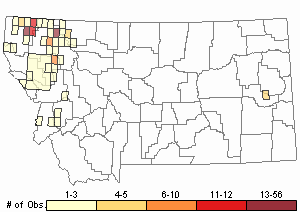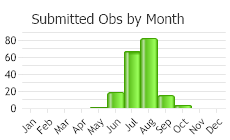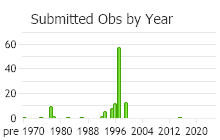View in other NatureServe Network Field Guides
NatureServe
Montana
Utah
Wyoming
Idaho
Wisconsin
British Columbia
South Carolina
Yukon
California
New York
Dusky Dicranum Moss - Dicranum fuscescens
General Description
Plants: Acrocarpous (Vitt 1988). Growing in open clumps of erect shoots, pale green, deep green with brown tones (FNA 2007), or green with yellow tones (Lawton 1971). Stems mostly 1-6 cm tall (rarely reaching 18 cm); rhizoids pale or russet, barely to strongly covering the stem in woolly mats (FNA 2007).
Leaves: Somewhat to very spiraled and curled when dry, curved and pointing toward one side of the stem, sometimes strongly so (FNA 2007), seldom straight or upright when moist (Smith 1980), not wavy (Lawton 1971), 3-10 mm in length, 0.6-1 mm in width, lance-shaped and cupped below, slowly tapering to the keeled, subulate apex; margins saw-toothed above mid-leaf, sometimes finely, or occasionally smooth throughout; costa extending beyond the leaf tip, usually a bit rough above on the dorsal side from papillae or minute teeth, occasionally smooth, with no dorsal crests near the apex (FNA 2007).
Leaf Cells: Lamina of 1 layer of cells, the cells smooth or a little papillose proximally on the dorsal side, more papillose above dorsally, the cell walls bulging between cells somewhat, and one or both margins 2 cell-layers thick distally; upper laminal cells square to short and quadrangular, lower laminal cells narrow, not porose; alar cells distinct, inflated (FNA 2007), brownish (Smith 1980), the alar area occasionally reaching the nerve and 2 cell-layers thick; costa in X-section with ventral and dorsal stereid bands reaching the upper part of the leaf, guide cells in 1 row, the cells of the ventral epidermal layer not distinct and those of the dorsal layer a little larger than the adjacent stereids (FNA 2007).
Dicranum fuscescens var. fuscescens: Present in Montana. Plants smaller, the stems seldom reaching 10 cm, typically thick with leaves; margins saw-toothed above; costa with papillae or minute, sharp teeth above on the dorsal side (FNA 2007).
Dicranum fuscescens var. flexicaule: Plants larger, the stems 8-18 cm, the leaves uncrowded; margins mostly smooth; costa largely smooth above on the dorsal side (FNA 2007).
Phenology
Variety fuscescens: Fruit ripens in spring (FNA 2007).
Variety flexicaule: Fruit ripens in summer (FNA 2007).
Diagnostic Characteristics
Variety fuscescens: Occasionally confused with Dicranum acutifolium. The leaves of D. acutifolium typically have several waves and, in X-section, the laminal cell walls between cells bulge more (FNA 2007).
Range Comments
Dicranum fuscescens (variety undetermined): Known in Montana from Cascade, Flathead, Glacier, Granite, Lake, Lincoln, Park, Ravalli, and Sanders Counties (FNA 2007).
North American Range
Variety fuscescens: AK to NL and NS, WA s to CA, ID, MT, WY, SD, MN, WI and MI, OH s to TN, e to the coast and ne to ME, also GA and NM (FNA 2007). Known in Montana from Glacier National Park (Elliott 2016).
Variety flexicaule: YT, NT, BC and QC (FNA 2007).
Observations in Montana Natural Heritage Program Database
Number of Observations: 191
(Click on the following maps and charts to see full sized version)
Map Help and Descriptions
Relative Density

Recency



 (Observations spanning multiple months or years are excluded from time charts)
(Observations spanning multiple months or years are excluded from time charts)
Habitat
Variety fuscescens: Decaying wood, tree bases, soil or humus overlying stone, stone ledges and crags, occasionally bogs; coniferous and deciduous forests. Elevation: 30-7550 feet (FNA 2007).
Variety flexicaule: Damp humus overlying the ground, bogs; coniferous woodlands. Elevation: 2950-4270 feet (FNA 2007).
Reproductive Characteristics
Dioicous, sometimes female and male plants found in the same clumps. Inner perichaetial bracts enveloping the stem, narrowing suddenly above to a short acumen. Seta single, 10-35 mm tall (FNA 2007), typically brown, sometimes yellow or yellow with red tinges (Lawton 1971). Capsule bowed, tilted to level, deeply grooved when dry, a little constricted below the opening, deep brown to russet, 1-3 mm in length; peristome of 16 teeth, separated ca halfway down into 2 lobes (seldom 3), russet, with papillae above. Calyptra hood-like, hairless, sheltering much of the capsule, falling away easily (FNA 2007).
Variety fuscescens: Seta usually less than 25 mm tall (FNA 2007).
Variety flexicaule: Seta typically taller than 25 mm (FNA 2007).
Stewardship Responsibility
References
- Literature Cited AboveLegend:
 View Online Publication
View Online Publication Elliott, J.C. and A.K. Pipp. 2018. A Checklist of Montana Mosses (1880-2018). Updated 3 January, 2020. Montana Natural Heritage Program, Helena, Montana. 73 pp.
Elliott, J.C. and A.K. Pipp. 2018. A Checklist of Montana Mosses (1880-2018). Updated 3 January, 2020. Montana Natural Heritage Program, Helena, Montana. 73 pp. Flora of North America Editorial Committee, eds. 2007. Flora of North America North of Mexico. Volume 27. Bryophytes: Mosses, Part 1. Oxford University Press, Inc., NY. xxi + 713 pp.
Flora of North America Editorial Committee, eds. 2007. Flora of North America North of Mexico. Volume 27. Bryophytes: Mosses, Part 1. Oxford University Press, Inc., NY. xxi + 713 pp. Lawton, E. 1971. Moss Flora of the Pacific Northwest. Hattori Botanical Laboratory. Japan: Yamabuki-cho, Shinjuku-ku, Tokyo. 362 pages plus appendices.
Lawton, E. 1971. Moss Flora of the Pacific Northwest. Hattori Botanical Laboratory. Japan: Yamabuki-cho, Shinjuku-ku, Tokyo. 362 pages plus appendices. Smith, A.J.E. 1980. The Moss Flora of Britain and Ireland. Cambridge University Press, Cambridge. 705 pp.
Smith, A.J.E. 1980. The Moss Flora of Britain and Ireland. Cambridge University Press, Cambridge. 705 pp. Vitt, D. J. Marsh, and R. Bovey. 1988. Mosses, Lichens & Ferns of Northwest North America. Seattle, WA: University of Washington Press. 296 p.
Vitt, D. J. Marsh, and R. Bovey. 1988. Mosses, Lichens & Ferns of Northwest North America. Seattle, WA: University of Washington Press. 296 p.
- Additional ReferencesLegend:
 View Online Publication
View Online Publication
Do you know of a citation we're missing? Crum, H.A. and L.E. Anderson. 1981. Mosses of Eastern North America. 2 volumes. Columbia University Press, New York. 1328 pp.
Crum, H.A. and L.E. Anderson. 1981. Mosses of Eastern North America. 2 volumes. Columbia University Press, New York. 1328 pp. Elliot, J. C. 1993. Second checklist of Montana mosses. Unpublished report. U.S. Forest Service, Region 1. Missoula, MT. 45 pp.
Elliot, J. C. 1993. Second checklist of Montana mosses. Unpublished report. U.S. Forest Service, Region 1. Missoula, MT. 45 pp. Lawton, E. 1971. Keys for the Identification of the Mosses on the Pacific Northwest. Reprinted from 'Moss Flora of the Pacific Northwest'. Published as Supplement No. 2 of the Journal of the Hattori Botanical Laboratory. Nichinan, Miyazaki, Japan. 66 pp.
Lawton, E. 1971. Keys for the Identification of the Mosses on the Pacific Northwest. Reprinted from 'Moss Flora of the Pacific Northwest'. Published as Supplement No. 2 of the Journal of the Hattori Botanical Laboratory. Nichinan, Miyazaki, Japan. 66 pp. Malcolm, B., N. Malcolm, J. Shevock, and D. Norris. 2009. California Mosses. Nelson, New Zealand: Micro-Optics Press. 430 pp.
Malcolm, B., N. Malcolm, J. Shevock, and D. Norris. 2009. California Mosses. Nelson, New Zealand: Micro-Optics Press. 430 pp.
- Web Search Engines for Articles on "Dusky Dicranum Moss"





